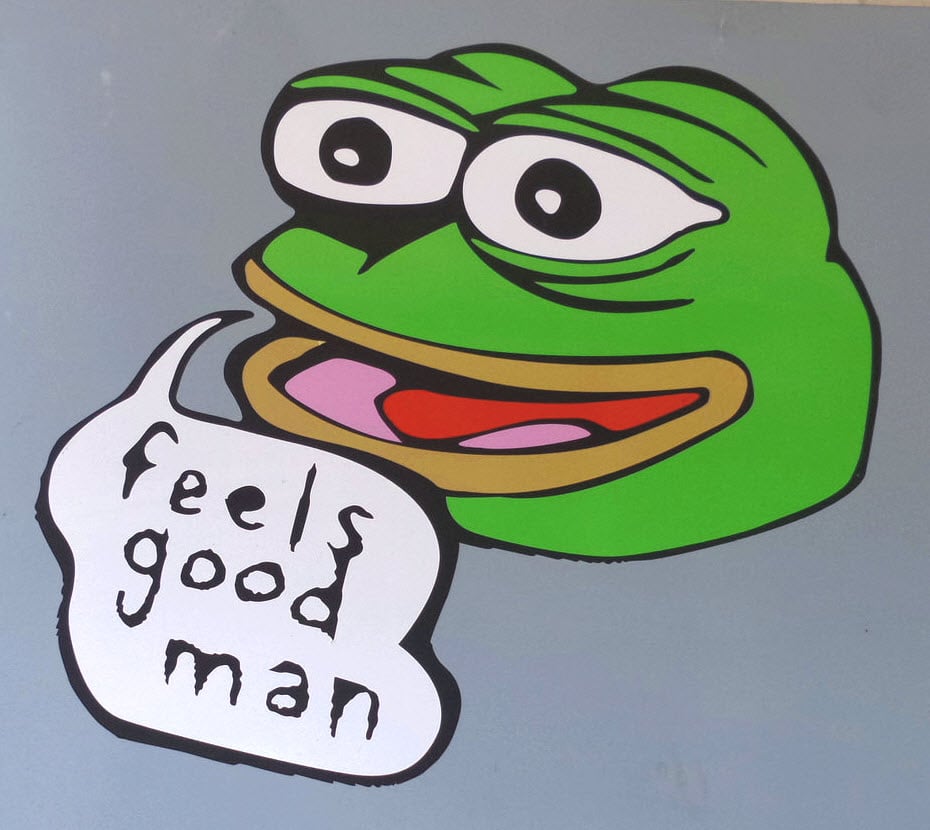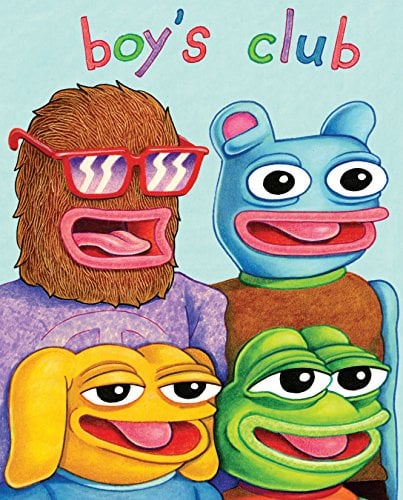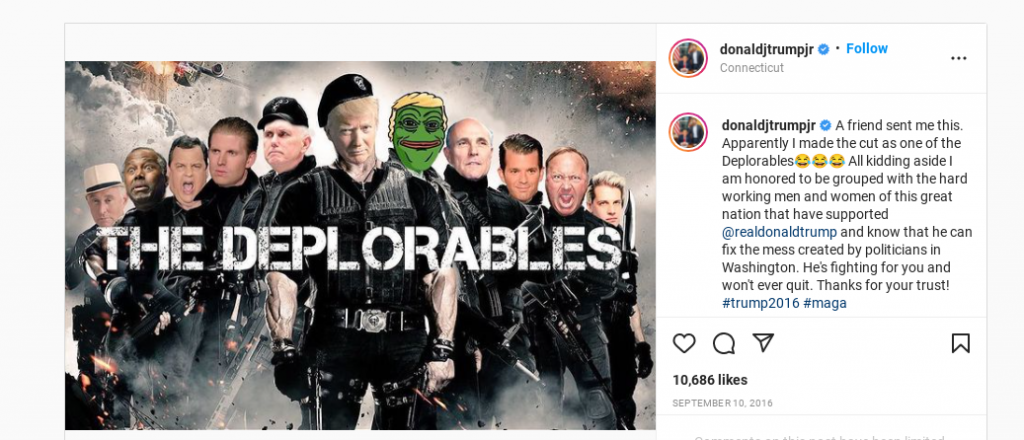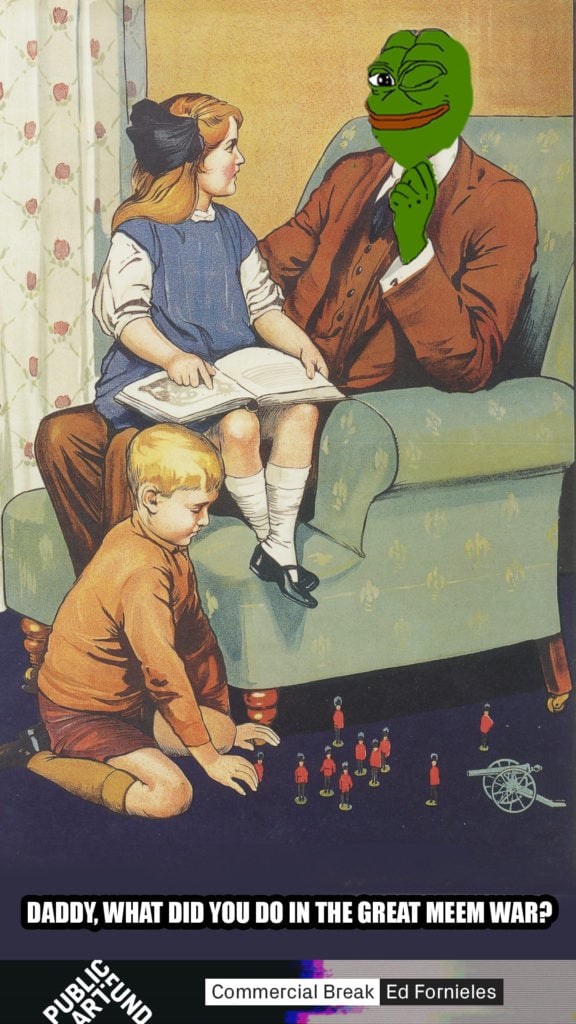Artnet NFT
The True Story Behind the Origins of Pepe the Frog
We're resurfacing the Art Angle's conversation with the creators of "Feels Good Man," a documentary about Pepe and his creator's battle to win back his image.

We're resurfacing the Art Angle's conversation with the creators of "Feels Good Man," a documentary about Pepe and his creator's battle to win back his image.

Artnet Auctions

In November 2020, Artnet’s Art Angle podcast interviewed Arthur Jones and Giorgio Angelini, the creators of an award-winning documentary “Feels Good Man.” The film traces the history and multiple interpretations of a cartoon character named “Pepe the Frog,” the heavy-lidded, endearing protagonist of Matt Furie’s 2005 comic zine Boy’s Club.
For a generation of internet aficionados, Furie’s innocent MySpace post of a black-and-white Pepe along with the frog’s now-iconic comment “feels good, man” became a blank canvas on which to project all kinds of expressions—happy frog, sad frog, bad frog.
In a cautionary tale that shows how images take on a life of their own online, Pepe later went viral for a much darker reason. During the 2016 election, the image was co-opted by a particular brand of alt-right activists on the platform 4chan.
The documentary traces Furie’s efforts to reclaim his creation and restore Pepe’s reputation. It also serves to illuminate the origins of the NFT project Rare Pepe. Between 2016 and 2018, the Rare Pepe project expanded to encompass more than 1,700 artworks centered on the beloved character. In October 2021, Furie also contributed his own Pepe illustration to the series.
The OG project, hosted on a Bitcoin blockchain branch called counterparty, started long before NFTs became a global phenomenon. In 2021, some of the Rare Pepes’ founding members infused the project with new life, producing more than 250 new digital works, many of which are animated and include original soundtracks.
Ahead of Artnet Auctions’s forthcoming NFT sale “Feels Rare Man,” our specialists are resurfacing this important podcast about cultural appropriation, freedom of speech, and the power of images in the digital landscape.
You can listen to the episode in full here.

Giorgio Angelini and Arthur Jones speak onstage during the “Feels Good Man” panel at Acura Festival Village on January 26, 2020 in Park City, Utah. (Photo by Michael Kovac/Getty Images for Acura)
Let’s talk specifically about how Pepe became a political meme, because there’s a big jump from this indie comic to what it becomes when 4chan gets a hold of it, and then into the 2016 elections.
Arthur Jones: We tell a 10-year story of Pepe on the internet. Pepe went from this “feels good, man” frog, which was largely an innocuous image for people to respond to online, before emojis, before the flexible discourse of text messaging. I don’t think most people knew anything about Matt’s artwork. They just thought this frog was immediately arresting. There was something cute and creepy about the frog.
So we chart how Pepe becomes this emoji, essentially. He goes from the “feels good, man” frog to the “feels sad, man” frog to the “feels bad, man” frog. Then ultimately, Pepe becomes more and more irrational and angry, and this is happening at the same time when there’s a real break in America and the Republican Party’s sole basis is aggrievement, and that’s why Donald Trump became so popular. We trace how Pepe becomes angry and emotional at the same time as the internet becomes angry and emotional.

The cover of Matt Furie’s Boy’s Club. Courtesy of the artist.
One of the things I appreciate that your film does is to drill back to the original context. Originally, it’s this non-sequitur comedy series about college friends hanging out, and then the after-college moment when you don’t really know what you’re doing. The comic is originally called Boy’s Club, about four young men living together in a sort of goofing-around-with-your-bros way. The culture that develops on 4chan is very much organized around this identity of being a man who’s cut off from women.
Giorgio Angelini: There’s one particular panel where Pepe transforms from the “feels good, man” frog to the “feels sad, man” frog that coincides with the financial meltdown of 2008, which coincides with these groups of predominantly young men online who are all talking about how the world is conspiring against them.
When the commoditization of social media comes in, and Pepe has already been very well established as the mascot of the internet, he starts to get coopted by what they pejoratively refer to as the “normies.” “Normies” start using Pepe and there’s a very predictable punk rock response from these young men who have been using Pepe for years. They say, We’re going to punkify or Nazify Pepe, and make him so grotesque that pop culture won’t be able to ever use it again. That begets this next phase, the hyper–charging of it, and the confluence of the election.
AJ: 4chan was really its own creative community. Before 4chan became synonymous with the alt-right, it was actually a place where movements like Occupy Wall Street came out of.
The film cycles through these larger rings that make you think about what has happened in the culture in the last 10 years, especially the cultural sensibility that developed online. Matt seems to be someone with one foot in both worlds. What happens to him online happens behind his back, right?
GA: Yeah. In some sense, Matt is an incredible protagonist because I think a lot of people may identify with his struggle in some way. Maybe you’re not specifically a cartoonist who had your artwork co-opted by evil forces. But maybe you feel like the world around you has changed really dramatically. Your sense of reality has been taken from you.

Matt Furie and Arthur Jones from Feels Good Man. (Photo by Emily Assiran/Getty Images for Pizza Hut)
He’s a really compelling figure because he is such an innocent, in some way. The first iteration of Pepe really is this innocent comic book about guys farting around an apartment together.
AJ: In the same way that Pepe was kidnapped from Matt, a lot of us feel as though consensus reality has been kidnapped from us because of social media and the misinformation and the antagonism that happens on those platforms. Matt is indicative of how subculture worked in the ‘90s for late Gen X. Subculture was defined by the community that you were part of, and Matt is very much a product of this very specific community in the San Francisco Mission. He was an illustrator within this larger music scene, a very DIY scene. And then we see how subculture for the next generation is completely defined by online communities that are not really based in person-to-person contact. It’s a different scene, and that’s the way subculture works now.
GA: There’s a famous book and movie about San Francisco street art culture called Beautiful Losers, the Barry McGee-art kind of scene has the same kind of cartoon-based, whimsical, colorful ideas that were in dialogue with the indie comic scene around Matt Furie. Then it’s interesting to take that line, late Gen-X, Beautiful Loser’s idea, and see how that morphs into the Pepe meme.
You have this incredible—or horrifying, depending on how you look at it—interview with Donald Trump’s web strategist who helped tap into Pepe. It’s interesting to compare that incident to the Obama “Hope” poster that Shepard Fairey designed in 2008, which also came out of a street art sensibility. Very consciously, this guy discovers this image, manipulates this image, and it taps into this other creative community with another kind of cultural energy. And he very consciously talks to you guys about it.
GA: He’s very attuned to how art and politics and propaganda all conspire. Because memes offer, for the first time, an opportunity that inverts the relationship between the politician and the voter, between the masses and the elite, in some way.
You as a keyboard warrior can create a meme. If it gets retweeted by the president, all of a sudden you’re sitting at the center of a massive political machine as just a single person. There’s a lot of power in that, and you can see, in a strange way, how it democratizes politics, but also how it gets perverted very easily. Donald Trump hosted at least two events, one at his country club in Florida and one in the White House, where he specifically invited meme artists to celebrate their work.

Screenshot of Donald Trump Jr. Instagram.
Your film really got me thinking about how the history of Pepe mirrors the history of people’s perceptions of internet culture. It starts out as this funny, off-beat, and weird kind of distraction, then it morphs into this excitingly unconfined phenomenon that moves into all these new spaces, then it turns nasty and scary. We’ve plugged our brains into this machine where everyone can see each other’s thoughts. What does that mean for how culture works, or how art works?
AJ: In pretty much every interview we did, someone would either say you can’t put the genie back in the bottle, or you can’t put the cat back in the bag. For us, the conversation became less of an artistic one, and ultimately one that was based more around the gig economy. As an artist now, the only way for [Furie] to really eke out a living as a commercial artist is to think about himself as a brand. There was a moment when there were people that would see a Matt Furie artwork, recognize it, maybe as the guy who did Pepe, and assume that it was done by a neo-Nazi or a white supremacist.
Pepe as a brand was getting corrupted, maligned, and destroyed. Matt’s want to reclaim Pepe for copyright is something that was done out of a real personal need for him to fight back against people like Richard Spencer who were using it as propaganda. It’s also something that he really had to do to become a provider for his family, and to make a career as an artist. He had to protect what was his.
GA: It’s his personal being, his psyche. That’s what’s so paradoxically infuriating about this. For one group of people who are used to engaging with Pepe, it was completely free of context. Then suddenly all these people are unknowingly destroying his life and his potential to make money because he wasn’t able to really define his own narrative.

Ed Fournieles, Memewar. Courtesy of the Public Art Fund.
You mentioned putting the genie back in the bottle. Talk about some of his efforts, the tools he tried to use.
AJ: In the movie, we talk about two distinct periods where Matt was trying to set the record straight. The first was something called the Save Pepe campaign, and this was at the height of Pepe’s toxicity. It was a hashtag, #SavePepe.
He encouraged all of his fellow illustrators and artists to make memes of Pepe that were peaceful, hippie sentiments, with peace signs and hearts. Matt knew that was something that was going to be viewed as a little naïve, or easily twisted and co-opted. But it was something he felt like he could actually do that was positive, and at the time he was feeling isolated and lonely.
The second was that Matt found a law firm that was willing to take the case on pro bono. It reached this moment of mainstream saturation where you could convince a law firm that was big enough to come in and help him. Before, he didn’t have the ability to find a lawyer like that because the case didn’t have that level of notoriety.
He found these two great copyright attorneys, Stephanie Lin and Louis Tompros, who work at this big law firm called Wilmer Hale. They came in and were able to give Matt the legal firepower to go against people who were specifically using Pepe as propaganda, or to profit from their extremist movement. For example, Richard Spencer was using Pepe as the logo for his podcast, and they got him to stop doing that. There’s also an internet provocateur who is a white nationalist named Baked Alaska, and they got him to stop using Pepe. In the film, we chart how the lawyers helped Matt get Alex Jones to remove Pepe from his web store.
That was a pretty hard process for Matt. He feels very uncomfortable in those kind of situations. We don’t think the movie’s preachy or anything, but we do think the movie speaks to this very simple truth.